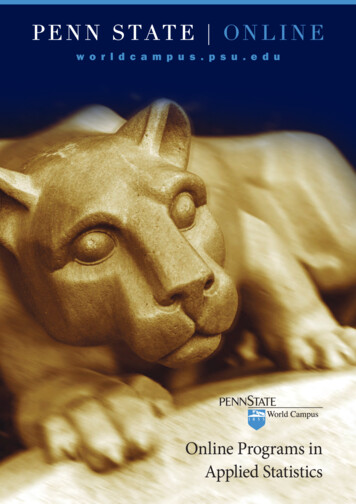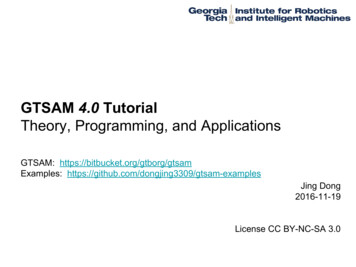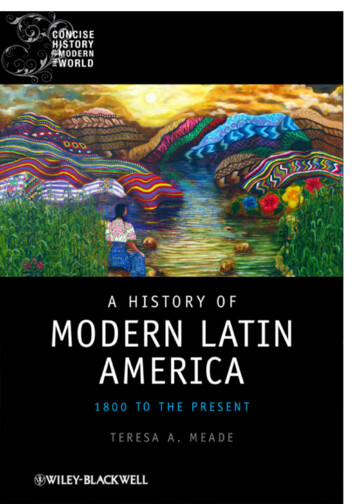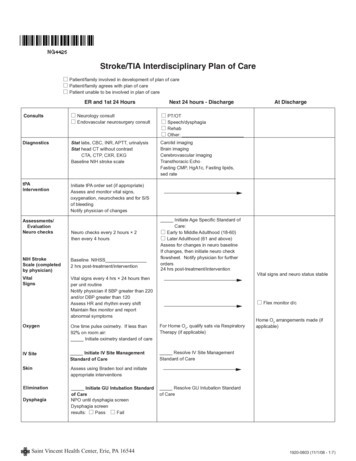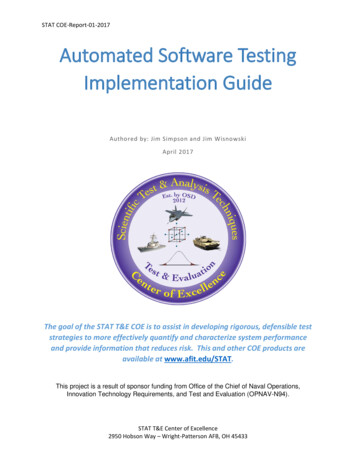![ArXiv:1811.12386v3 [stat.ML] 5 Dec 2018 - Columbia University](/img/36/nassar-20-28linderman-29-2c-20tree-structured-20recurrent-20switching-20linear-20dynamical-20systems.jpg)
Transcription
arXiv:1811.12386v3 [stat.ML] 5 Dec 2018T REE -S TRUCTURED R ECURRENT S WITCHING L INEARDYNAMICAL S YSTEMS FOR M ULTI -S CALE M ODELINGJosue NassarDepartment of Electrical & Computer EngineeringStony Brook UniversityStony Brook, NY 11794 USAjosue.nassar@stonybrook.eduScott W. LindermanDepartment of StatisticsColumbia UniversityNew York, NY 10027scott.linderman@gmail.comMónica F. BugalloDepartment of Electrical & Computer EngineeringStony Brook UniversityStony Brook, NY, 11794 USAmonica.bugallo@stonybrook.eduIl Memming ParkDepartment of Neurobiology and BehaviorStony Brook UniversityStony Brook, NY, 11794 USAmemming.park@stonybrook.eduA BSTRACTMany real-world systems studied are governed by complex, nonlinear dynamics. Bymodeling these dynamics, we can gain insight into how these systems work, makepredictions about how they will behave, and develop strategies for controlling them.While there are many methods for modeling nonlinear dynamical systems, existingtechniques face a trade off between offering interpretable descriptions and makingaccurate predictions. Here, we develop a class of models that aims to achieveboth simultaneously, smoothly interpolating between simple descriptions and morecomplex, yet also more accurate models. Our probabilistic model achieves thismulti-scale property through a hierarchy of locally linear dynamics that jointlyapproximate global nonlinear dynamics. We call it the tree-structured recurrentswitching linear dynamical system. To fit this model, we present a fully-Bayesiansampling procedure using Pólya-Gamma data augmentation to allow for fast andconjugate Gibbs sampling. Through a variety of synthetic and real examples, weshow how these models outperform existing methods in both interpretability andpredictive capability.1I NTRODUCTIONComplex systems can often be described at multiple levels of abstraction. A computer program can becharacterized by the list of functions it calls, the sequence of statements it executes, or the assemblyinstructions it sends to the microprocessor. As we zoom in, we gain an increasingly nuanced view ofthe system and its dynamics. The same is true of many natural systems. For example, brain activitycan be described in terms of high-level psychological states or via detailed ion channel activations;different tasks demand different levels of granularity. One of our principal aims as scientists is toidentify appropriate levels of abstraction for complex natural phenomena and to discover the dynamicsthat govern how these systems behave at each level of resolution.Modern machine learning offers a powerful toolkit to aid in modeling the dynamics of complexsystems. Bayesian state space models and inference algorithms enable posterior inference of the latentstates of a system and the parameters that govern their dynamics (Särkkä, 2013; Barber et al., 2011;Doucet et al., 2001). In recent years, this toolkit has been expanded to incorporate increasingly flexiblecomponents like Gaussian processes (Frigola et al., 2014) and neural networks (Chung et al., 2015;Johnson et al., 2016; Gao et al., 2016; Krishnan et al., 2017) into probabilistic time series models. Inneuroscience, sequential autoencoders offer highly accurate models of brain activity (Pandarinathet al., 2018). However, while these methods offer state of the art predictive models, their dynamicsare specified at only the most granular resolution, leaving the practitioner to tease out higher levelstructure post hoc.1
Here we propose a probabilistic generative model that provides a multi-scale view of the dynamicsthrough a hierarchical architecture. We call it the tree-structured recurrent switching linear dynamicalsystem, or TrSLDS. The model builds on the recurrent SLDS (Linderman et al., 2017) to approximatelatent nonlinear dynamics through a hierarchy of locally linear dynamics. Once fit, the TrSLDS canbe queried at different levels of the hierarchy to obtain dynamical descriptions at multiple levelsof resolution. As we proceed down the tree, we obtain higher fidelity, yet increasingly complex,descriptions. Thus, depth offers a simple knob for trading off interpretability and flexibility. Thekey contributions are two-fold: first, we introduce a new form of tree-structured stick breaking formultinomial models that strictly generalizes the sequential stick breaking of the original rSLDS,while still permitting Pólya-gamma data augmentation (Polson et al., 2013) for efficient posteriorinference; second, we develop a hierarchical prior that links dynamics parameters across levels of thetree, thereby providing descriptions that vary smoothly with depth.The paper is organized as follows. Section 2 provides background material on switching lineardynamical systems and their recurrent variants. Section 3 presents our tree-structured model andSection 4 derives an efficient fully-Bayesian inference algorithm for the latent states and dynamicsparameters. Finally, in Section 5 we show how our model yields multi-scale dynamics descriptionsfor synthetic data from two standard nonlinear dynamical systems—the Lorenz attractor and theFitzHugh-Nagumo model of nonlinear oscillation—as well as for a real dataset of neural responses tovisual stimuli in a macaque monkey.2BACKGROUNDLet xt Rdx and yt Rdy denote the latent state and the observation of the system at time trespectively. The system can be described using a state-space model:xt f (xt 1 , wt ; Θ),yt g(xt , vt ; Ψ),wt Fwv t Fv(state dynamics)(observation)(1)(2)where Θ denotes the dynamics parameters, Ψ denotes the emission (observation) parameters, andwt and vt are the state and observation noises respectively. For simplicity, we restrict ourselves tosystems of the form:xt f (xt 1 ; Θ) wt , wt N (0, Q),(3)If the state space model is completely specified then recursive Bayesian inference can be applied toobtain an estimate of the latent states using the posterior p (x0:T y1:T ) (Doucet et al., 2001). Howeverin many applications, the parametric form of the state space model is unknown. While there existmethods that perform smoothing to obtain an estimate of x0:T (Barber, 2006; Fox et al., 2009; Djuric& Bugallo, 2006), we are often interested in not only obtaining an estimate of the continuous latentstates but also in learning the dynamics f (·; Θ) that govern the dynamics of the system.In the simplest case, we can take a parametric approach to solving this joint state-parameter estimationproblem. When f (·; Θ) and g(·; Ψ) are assumed to be linear functions, the posterior distributionover latent states is available in closed-form and the parameters can be learned via expectationmaximization. On the other hand, we have nonparametric methods that use Gaussian processes andneural networks to learn highly nonlinear dynamics and observations where the joint estimation isuntractable and approximations are necessarily imployed (Zhao & Park, 2016; 2018; Frigola et al.,2014; Sussillo et al., 2016). Switching linear dynamical systems (SLDS) (Ackerson & Fu, 1970;Chang & Athans, 1978; Hamilton, 1990; Ghahramani & Hinton, 1996; Murphy, 1998) balancebetween these two extremes, approximating the dynamics by stochastically transitioning between asmall number of linear regimes.2.1S WITCHING L INEAR DYNAMICAL S YSTEMSSLDS approximate nonlinear dynamics by switching between a discrete set of linear regimes. Anadditional discrete latent state zt {1, . . . , K} determines the linear dynamics at time t,xt xt 1 Azt xt 1 bzt wt ,dx dxdxwt N (0, Qzt )(4)where Ak , Qk Rand bk R for k 1, . . . , K. Typically, zt is endowed with Markoviandynamics, Pr(zt zt 1 k) πk . The conditionally linear dynamics allow for fast and efficient2
(sequential) stick breakingtree-structured stick breakingFigure 1: State probability allocation through stick-breaking in standard rSLDS and the TrSLDS.learning of the model and can utilize the learning tools developed for linear systems (Haykin, 2001).While SLDS can estimate the continuous latent states x0:T , the assumption of Markovian dynamicsfor the discrete latent states severely limits their generative capacity.2.2R ECURRENT S WITCHING L INEAR DYNAMICAL S YSTEMSRecurrent switching linear dynamical systems (rSLDS) (Linderman et al., 2017), also known asaugmented SLDS (Barber, 2006), are an extension of SLDS where the transition density of thediscrete latent state depends on the previous location in the continuous latent spacezt xt 1 , {R, r} πSB (νt ) ,νt Rxt 1 r,(5)(6)where R RK 1 dx and r RK 1 represents hyperplanes. πSB : RK 1 [0, 1]K maps fromthe reals to the probability simplex via stick-breaking: Y(1)(K)(k)πSB (ν) πSB (ν), · · · , πSB (ν) , πSB σ(νk )σ ( νj ) ,(7)j kQK 1(K)for k 1, . . . , K 1 and πSB k 1 σ ( νk ) where νk is the kth component of of ν andσ(ν) (1 e ν ) 1 is the logistic function (Fig. 1). By including this recurrence in the transitiondensity of zt , the rSLDS partitions the latent space into K sections, where each section follows itsown linear dynamics. It is through this combination of locally linear dynamical systems that therSLDS approximates eq. (3); the partitioning of the space allows for a more interpretable visualizationof the underlying dynamics.Recurrent SLDS can be learned efficiently and in a fully Bayesian manner, and experiments empirically show that they are adept in modeling the underlying generative process in many cases. However,the stick breaking process used to partition the space poses problems for inference due to its dependence on the permutation of the discrete states {1, · · · , K} (Linderman et al., 2017).3T REE -S TRUCUTRED R ECURRENT S WITCHING L INEAR DYNAMICALS YSTEMSBuilding upon the rSLDS, we propose the tree-structured recurrent switching linear dynamical system(TrSLDS). Rather than sequentially partitioning the latent space using stick breaking, we use a treestructured stick breaking procedure (Adams et al., 2010) to partition the space.Let T denote a tree structure with a finite set of nodes { , 1, · · · , N }. Each node n has a parentnode denoted by par(n) with the exception of the root node, , which has no parent. For simplicity,we initially restrict our scope to balanced binary trees where every internal node n is the parent oftwo children, left(n) and right(n). Let child(n) {left(n), right(n)} denote the set of childrenfor internal node n. Let Z T denote the set of leaf nodes, which have no children. Let depth(n)denote the depth of a node n in the tree, with depth( ) 0.At time instant t, the discrete latent state zt is chosen by starting at the root node and traversing downthe tree until one of the K leaf nodes are reached. The traversal is done through a sequence of left/right3
choices by the internal nodes. Unlike in standard regression trees where the choices are deterministic(Lakshminarayanan, 2016), we model the choices as random variables. The traversal through the treecan be described as a stick breaking process. We start at the root node with a unit-length stick π 1,which we divide between its two children. The left child receives a fraction πleft( ) σ(ν ) andthe right child receives the remainder πright( ) 1 σ(ν ) such that ν R specifies the left/rightbalance. This process is repeated recursively, subdividing πn into two pieces at each internal nodeuntil we reach the leaves of the tree (Fig. 1). The stick assigned to each node is thus,( I[n right(par(n))]σ(νpar(n) )I[n left(par(n))] 1 σ(νpar(n) )πpar(n) n 6 ,πn (8)1n .We incorporate this into the TrSLDS by allowing νn to be a function of the continuous latent stateνn (xt 1 , Rn , rn ) RnT xt 1 rn ,(9)where the parameters Rn and rn specify a linear hyperplane in the continuous latent state space. As thecontinuous latent state xt 1 evolves, the left/right choices become more or less probable. This in turnchanges the probability distribution πk (xt 1 , Γ, T ) over the K leaf nodes, where Γ {Rn , rn }n T .In the TrSLDS, these leaf nodes correspond to the discrete latent states of the model, such that foreach leaf node k,p (zt k xt 1 , Γ, T ) πk (xt 1 , Γ, T ).(10)In general, the tree-structured stick-breaking is not restricted to balanced binary trees. We can allowmore than two children through an ordered sequential stick-breaking at each level. In this sense,tree-structured stick-breaking is a strict generalization of stick-breaking. We also note that similar torSLDS, the model can be made more flexible by introducing a dependence on the previous discretelatent in eq. (9) but for the rest of the paper, we stick to eq. (8).3.1A H IERARCHICAL DYNAMICS P RIOR THAT R ESPECTS THE T REE S TRUCTURESimilar to standard rSLDS, the dynamics are conditionally linear given a leaf node zt . A priori, it isnatural to expect that locally linear dynamics of nearby regions in the latent space are similar. Thus,in the context of tree-structured stick breaking, we impose that partitions that share a common parentshould have similar dynamics. We explicitly model this by enforcing a hierarchical prior on thedynamics that respects the tree structure.Let {An , bn } be the dynamics parameters associated with node n. Although the locally lineardynamics of a discrete state are specified by the leaf nodes, we introduce dynamics at the internalnodes as well. These internal dynamics serve as a link between the leaf node dynamics via ahierarchical prior,vec([An , bn ]) vec([Apar(n) , bpar(n) ]) N (vec([Apar(n) , bpar(n) ]), Σn ),(11)where vec(·) is the vectorization operator. The prior on the root node isvec ([A , b ]) N (0, Σ ) .(12)We impose the following constraint on the covariance matrix of the priorΣn λdepth(n) Σ ,(13)where λ (0, 1) is a hyper parameter that dictates how "close" a parent and child are to one another.The prior over the parameters can be written as, where the affine term and the vec(·) operator aredropped for compactness,YYYp({An }n T ) p(A )p(Ai A )p(Aj Ai ) . . .p(Az Apar(z) ).(14)i child( )j child(i)z ZIt is through this hierarchical tree-structured prior that TrSLDS obtains a multi-scale view of thesystem. Parents are given the task of learning a higher level description of the dynamics over a largerregion while children are tasked with learning the nuances of the dynamics. The use of hierarchicalpriors also allows for neighboring sections of latent space to share common underlying dynamics4
inherited from their parent. TrSLDS can be queried at different levels, where levels deeper in the treeprovide more resolution.TrSLDS shares some features with regression trees (Lakshminarayanan, 2016), even though regressiontrees are primarily used for standard, static regression problems. The biggest differences are that ourtree-structured model has stochastic choices and the internal nodes contribute to smoothing acrosspartitions through the corresponding hierarchical prior.There are other hierarchical extensions of SLDS that have been proposed in the literature. In Stanculescu et al. (2014), they propose adding a layer to factorized SLDS where the top-level discretelatent variables determine the conditional distribution of zt , with no dependence on xt 1 . While thetree-structured stick-breaking used in TrSLDS is also a hierarchy of discrete latent variables, themodel proposed in Stanculescu et al. (2014) has no hierarchy of dynamics, preventing it from obtaining a multi-scale view of the dynamics. In Zoeter & Heskes (2003), the authors construct a tree ofSLDSs where an SLDS with K possible discrete states is first fit. An SLDS with M discrete states isthen fit to each of the K clusters of points. This process continues iteratively, building a hierarchicalcollection of SLDSs that allow for a multi-scale, low-dimensional representation of the observed data.While similar in spirit to TrSLDS, there are key differences between the two models. First, it is throughthe tree-structured prior that TrSLDS obtains a multi-scale view of the dynamics, thus we only need tofit one instantiation of TrSLDS; in contrast, they fit a separate SLDS for each node in the tree, whichis computationally expensive. There is also no explicit probabilistic connection between the dynamics of a parent and child in Zoeter & Heskes (2003). We also note that TrSLDS aims to learn a multiscale view of the dynamics while Zoeter & Heskes (2003) focuses on smoothing, that is, they aim tolearn a multi-scale view of the latent states corresponding to data but not suitable for forecasting.In the next section we show an alternate view of TrSLDS which we will refer to as the residual modelin which internal nodes do contribute to the dynamics. Nevertheless, this residual model will turn outto be equivalent to the TrSLDS.3.2R ESIDUAL M ODELLet {Ãn , b̃n } be the linear dynamics of node n and let path(n) ( , . . . , n) be the sequence ofnodes visited to arrive at node n. In contrast to TrSLDS, the dynamics for a leaf node are nowdetermined by all the nodes in the tree:p(xt xt 1 , Θ̃, zt ) N (xt xt 1 Āzt xt 1 b̄zt , Q̃zt ),XXÃj , b̄zt b̃j ,Āzt j path(zt )(15)(16)j path(zt )We model the dynamics to be independent a priori, where once again the vec(·) operator and theaffine term aren’t shown for compactness,p({Ãn }n T ) Yp(Ãn ),p(Ãn ) N (0, Σ̃n ),(17)n Twhere Σ̃n λ̃depth(n) Σ̃ and λ̃ (0, 1).The residual model offers a different perspective of TrSLDS. The covariance matrix can be seen asrepresenting how much of the dynamics a node is tasked with learning. The root node is given thebroadest prior because it is present in eq. (16) for all leaf nodes; thus it is given the task of learningthe global dynamics. The children then have to learn to explain the residuals of the root node. Nodesdeeper in the tree become more associated with certain regions of the space, so they are tasked withlearning more localized dynamics which is represented by the prior being more sharply centered on0. The model ultimately learns a multi-scale view of the dynamics where the root node captures acoarse estimate of the system while lower nodes learn a much finer grained picture. We show thatTrSLDS and residual model yield the same joint distribution (See A for the proof).Theorem 1. TrSLDSP and the residual model are equivalent if the following conditions are true:A Ã , An j path(n) Ãj , Qz Q̃z z leaves(T ), Σ Σ̃ and λ λ̃5
4BAYESIAN I NFERENCEThe linear dynamic matrices Θ, the hyperplanes Γ {Rn , rn }n T \Z , the emission parameters Ψ,the continuous latent states x0:T and the discrete latent states z1:T must be inferred from the data.Under the Bayesian framework, this implies computing the posterior,p (x0:T , z0:T , Θ, Ψ, Γ y1:T ) p (x0:T , z1:T , Θ, Ψ, Γ, y1:T ).p (y1:T )(18)We perform fully Bayesian inference via Gibbs sampling (Brooks et al., 2011) to obtain samplesfrom the posterior distribution described in eq. (18). To allow for fast and closed form conditionalposteriors, we augment the model with Pólya-gamma auxiliary variables Polson et al. (2013).4.1P ÓLYA -G AMMA AUGMENTATIONConsider a logistic regression from regressor xn Rdx to categorical distribution zn {0, 1}; thelikelihood is T znNexn βYp(z1:N ) .(19)T1 exn βn 1If a Gaussian prior is placed on β then the model is non-conjugate and the posterior can’t be obtainedin closed form. To circumvent this problem Polson et al. (2013) introduced a Pólya-Gamma (PG)augmentation scheme. This augmentation scheme is based on the following integral identity aZ eψ21 b κψ 2 ee 2 ωψ p(ω)dω(20)bψ(1 e )0where κ a b/2 and ω PG(b, 0). Setting ψ xT β, it is evident that the integrand is a kernelfor a Gaussian. Augmenting the model with PG axillary r.v.s {ωn }Nn 1 , eq. (19) can be expressed as T z nZ NNNexn βYYY221κn ψn 12 ωn ψnp(z1:N ) ep(ω)dω Eωn [e 2 (ωn ψn 2κn ψn ) ].ennTβx1 e n0n 1n 1n 1(21)Conditioning on ωn , the posterior of β isp(β ω1:N , z1:N , x1:N ) p(β)NY12e 2 (ωn ψn 2κn ψn )(22)n 1where ψn xTn β and κn zn 12 . It can be shown that the conditional posterior of ωn is also PGwhere ωn β, xn , zn PG(1, ψn ) (Polson et al., 2013).4.2C ONDITIONAL P OSTERIORSThe structure of the model allows for closed form conditional posterior distributions that are easy tosample from. For clarity, the conditional posterior distributions for the TrSLDS are given below:1. The linear dynamic parameters (Ak , bk ) and state variance Qk of a leaf node k are conjugatewith a Matrix Normal Inverse Wishart (MNIW) priorp((Ak , bk ), Qk x0:T , z1:T ) p((Ak , bk ), Qk )TYN (xt xt 1 Azt xt 1 bzt , Qzt )1[zt k] .t 12. The linear dynamic parameters of an internal node n are conditionally Gaussian given aGaussian prior on (An , bn )Yp((An , bn ) Θ n ) p((An , bn ) (Apar(n) , bpar(n) ))p((Aj , bj ) (An , bn )).j child(n)6
3. If we assume the observation model is linear and with additive white Gaussian noise thenthe emission parameters Ψ {(C, d), S} are also conjugate with a MNIW priorp((C, d), S x1:T , y1:T ) p((C, d), S)TYN (yt Cxt d, S).t 1We can also handle binomial observations through the use of Pólya-gamma augmentation.In the interest of space, the details are explained in Section B.1 in the Appendix.4. The choice parameters are logistic regressions which follow from the conditional posteriorp (Γ x0:T , z1:T ) p (Γ)TYp (zt xt 1 , Γ) p (Γ)t 1TYYt 1 n path(zt )\Z(eνn,t )1(left(n) path(zt ))1 eνn,twhere νn,t RnT xt 1 rn . The likelihood is of the same form as the left hand side ofeq. (20), thus it is amenable to the PG augmentation. Let ωn,t be the auxiliary Pólya-gammarandom variable introduced at time t for an internal node n. We can express the posteriorover the hyperplane of an internal node n as:p((Rn , rn ) x0:T , z1:T , ωn,1:T ) p((Rn , rn ))TYN (νn,t κn,t /ωn,t , 1/ωn,t )1(n path(zt )) ,t 1(23)where κn,t 21 1[j left(n)] 12 1[j right(n)], j child(n). Augmenting the modelwith Pólya-gamma random variables allows for the posterior to be conditionally Gaussianunder a Gaussian prior.5. Conditioned on the discrete latent states, the continuous latent states are Gaussian. However,the presence of the tree-structured recurrence potentials ψ(xt 1 , zt ) introduced by eq. (10)destroys the Gaussinity of the conditional. When the model is augmented with PG randomvariables ωn,t , the augmented recurrence potential, ψ(xt 1 , zt , ωn,t ), becomes effectivelyGaussian, allowing for the use of message passing for efficient sampling. Lindermanet al. (2017) shows how to perform message-passing using the Pólya-gamma augmentedrecurrence potentials ψ(xt , zt , wn,t ). In the interest of space, the details are explained inSection B.2 in the Appendix.6. The discrete latent variables z1:T are conditionally independent given x1:T thusp (zt k x1:T , Θ, Γ) Pp (xt xt 1 , θk ) p (zt k xt 1 , Γ), k leaves(T ).l leaves(T ) p (xt xt 1 , θl ) p (zt l xt 1 , Γ)7. The conditional posterior of the Pólya-Gamma random variables are also Pólya-Gamma:ωn,t zt , (Rn , rn ), xt 1 PG(1, νn,t ) .Due to the complexity of the model, good initialization is critical for the Gibbs sampler to convergeto a mode in a reasonable number of iterations. Details of the initialization procedure are containedin Section C in the Appendix.5E XPERIMENTSWe demonstrate the potential of the proposed model by testing it on a number of non-linear dynamical systems. The first, FitzHugh-Nagumo, is a common nonlinear system utilized throughout neuroscience to describe an action potential. We show that the proposed method can offer different anglesof the system. We also compare our model with other approaches and show that we can achievestate of the art performance. We then move on to the Lorenz attractor, a chaotic nonlinear dynamicalsystem, and show that the proposed model can once again break down the dynamics and offer aninteresting perspective. Finally, we apply the proposed method on the data from Graf et al. (2011).7,
ADtrue latent statesroot node vector fieldGgenerated trajectory from leaf leveltrue trajectorystartingpointBCinferred latent statestrue vector fieldnullclineE2nd layer vector fieldFleaf layer vector fieldHIdynamics rolled over timetrue2nd levelleaf leveltimek-step prediction performanceprediction horizon (k-steps)log speedFigure 2: TrSLDS applied to model the FitzHugh-Nagumo nonlinear oscillator. (a) The model wastrained on 100 trajectories with random starting points. (b) The model can infer the latent trajectories.(c) The true vector field of FHN is shown where color of the arrow represents log-speed. The twonullclines are plotted in yellow and green. (d-f) The vector fields display the multi-scale view learnedfrom the model where color of the arrows dictate log-speed The background color showcases thehierarchical partitioning learned by the model where the darker the color is, the higher the probabilityof ending up in that discrete state. As we go deeper in the tree, the resolution increases which isevident from the vector fields. (g) A deterministic trajectory from the leaf nodes (colored by mostlikely leaf node) with affine transformation onto a trajectory FHN (gray). (h) Plotting w and v overtime, we see that the second level captures some of the oscillations but ultimately converges to afixed point. The model learned by the leaf nodes captures the limit cycle accurately. (i) Performancescompared for multi-step prediction. We see that TrSLDS outperforms rSLDS.5.1F ITZ H UGH -NAGUMOThe FitzHugh-Nagumo (FHN) model is a 2-dimensional reduction of the Hodgkin-Huxley modelwhich is completely described by the following system of differential equations (Izhikevich, 2007):v3 w Iext ,τ ẇ v a bw.(24)3We set the parameters to a 0.7, b 0.8, τ 12.5, and Iext N (0.7, 0.04). We trained ourmodel with 100 trajectories where the starting points were sampled uniformly from [ 3, 3]2 . Each ofthe trajectories consisted of 430 time points, where the last 30 time pointswere of the trajectories 2 0used for testing. The observation model is linear and Gaussian where C , d [0.5, 0.5]0 2and S 0.01I2 where In is an identity matrix of dimension n. We set the number of leaf nodes tobe 4 and ran Gibbs for 1,000 samples; the last 50 samples were kept and we choose the sample thatproduced the highest log likelihood to produce Fig. 2 where the vector fields were produced using themode of the conditional posteriors of the dynamics.v̇ v To quantitatively measure the predictive power of TrSLDS, we compute the k-step predictive meansquared error, MSEk , and its normalized version, Rk2 , on a test set where MSEk and Rk2 are defined asMSEk T k1 X2kyt k ŷt k k2 ,T k t 08(T k)MSEkRk2 1 PT k,2t 0 kyt k ȳk2(25)
where ȳ is the average of a trial and ŷt k is the prediction at time t k which is obtained by (i) usingthe the samples produced by the sampler to obtain an estimate of x̂T given y1:T , (ii) propagate x̂T fork time steps forward to obtain x̂t k and then (iii) obtain ŷt k . We compare the model to LDS, SLDSand rSLDS for k 1, . . . , 30 over the last 30 time steps for all 100 trajectories (Fig. 2I).5.2AL ORENZ ATTRACTORtrue latent trajectoriesCrealization from level 2Esimulated trajectoriestrueleaf level2nd leveltimeBinferred latent trajectoriesDrealization from leaf nodesFk-step prediction performance1.00.500102030prediction horizon (k-steps)Figure 3: (a) The 50 trajectories used to train the model are plotted where the red "x" displays thestarting point of the trajectory. (b) The inferred latent states are shown, colored by their discretelatent state. (c) We see that the second layer approximates the Lorenz attractor with 2 ellipsoids. Atrajectory from the Lorenz attractor starting at the same initial point is shown for comparison. (d)Going one level lower in the tree, we see that in order to capture the nuances of the dynamics, each ofthe ellipsoids must be split in half. A trajectory from the Lorenz attractor is shown for comparison.(e) Plotting the dynamics, it is evident that the leaf nodes improve on it’s parent’s approximation. (f)The Rk2 demonstrates the predictive power of TrSLDS.Lorenz attractors are chaotic systems whose nonlinear dynamics are defined by,x 1 σ (x2 x1 ) ,x 2 x1 (ρ x3 ) x2 ,x 3 x1 x2 βx3 .The parameters were set to σ 10, ρ 28 and β 8/3. The data consisted of 50 trajectories, eachof length of 230 where the first 200 time points are used for training and the last 30 are used fortesting. The observation model was a projection onto 10 dimensional space with Gaussian noise.Weset the number of leaf nodes to be 4 and ran Gibbs for 1,000 samples; the last 50 samples were keptand we choose the sample that produced the highest log-likelihood to produce Fig. 3.The butterfly shape of the Lorenz attractor lends itself to being roughly approximated by two 2dimensional ellipsoids; this is exactly what TrSLDS learns in the second level of the tree. As isevident from Fig. 5B, the two ellipsoids don’t capture the nuances of the dynamics. Thus, the modelpartitions each of the ellipsoids to obtain a finer description. We can see that embedding the systemwith a hierarchical tree-structured prior allows for the children to build off its parent’s approximations.5.3N EURAL DATATo validate the model and inference procedure, we used the neural spike train data recorded fromthe primary visual cortex of an anesthetized macaque monkey collected by Graf et al. (2011). Thedataset is composed of short trials where the monkey viewed periodic temporal pattern of motions9
of 72 orientations, each repeated 50 times. Dimensionality reduction of the dataset showed that foreach orientation of the drifting grating stimulus, the neural response oscillates over time, but in astimulus dependent geometry captured in 3-dimensions (Zhao & Park, 2017). We used 50 trialseach from a subset of 4 stimulus orientations grouped in two (140 and 150 de
predictive capability. 1 INTRODUCTION Complex systems can often be described at multiple levels of abstraction. A computer program can be characterized by the list of functions it calls, the sequence of statements it executes, or the assembly instructions it sends to the microprocessor. As we zoom in, we gain an increasingly nuanced view of

